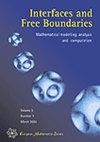离散-连续介质膜-颗粒模型中膜介导的力学相互作用能的可微性
IF 1
4区 数学
Q1 MATHEMATICS
引用次数: 3
摘要
我们考虑具有嵌入颗粒的生物膜的离散连续模型。膜是用连续的表面来表示的,而嵌入的粒子是用刚性的离散物体来描述的,这些物体可以在横向上自由移动和旋转。对于膜,我们考虑一个线性化的Canham-Helfrich能量泛函,并在粒子边界上施加高度和斜率边界条件,从而导致膜形状和粒子位置的耦合最小化问题。当考虑每个粒子位置的能量最优膜形状时,我们得到了一个简化的能量泛函,该泛函模拟了膜介导的机械粒子-粒子相互作用的隐式给定相互作用势。我们证明了这种相互作用势对粒子的位置和方向是可微的。此外,我们推导了导数的完全实用的表示,仅在定义好的膜的导数方面。这为应用最小化算法计算耦合系统的最小化值以及进一步研究膜介导的机械粒子-粒子相互作用的相互作用势打开了大门。通过数值算例对显式导数公式与差商近似的结果进行了比较。我们进一步演示了推导公式的应用,以实现梯度流的近似最佳粒子配置。本文章由计算机程序翻译,如有差异,请以英文原文为准。
On differentiability of the membrane-mediated mechanical interaction energy of discrete–continuum membrane–particle models
We consider a discrete-continuum model of a biomembrane with embedded particles. While the membrane is represented by a continuous surface, embedded particles are described by rigid discrete objects which are free to move and rotate in lateral direction. For the membrane we consider a linearized Canham-Helfrich energy functional and height and slope boundary conditions imposed on the particle boundaries resulting in a coupled minimization problem for the membrane shape and particle positions.
When considering the energetically optimal membrane shape for each particle position we obtain a reduced energy functional that models the implicitly given interaction potential for the membrane-mediated mechanical particle-particle interactions. We show that this interaction potential is differentiable with respect to the particle positions and orientations. Furthermore we derive a fully practical representation of the derivative only in terms of well defined derivatives of the membrane. This opens the door for the application of minimization algorithms for the computation of minimizers of the coupled system and for further investigation of the interaction potential of membrane-mediated mechanical particle-particle interaction.
The results are illustrated with numerical examples comparing the explicit derivative formula with difference quotient approximations. We furthermore demonstrate the application of the derived formula to implement a gradient flow for the approximation of optimal particle configurations.
求助全文
通过发布文献求助,成功后即可免费获取论文全文。
去求助
来源期刊
CiteScore
1.70
自引率
0.00%
发文量
17
审稿时长
>12 weeks
期刊介绍:
Interfaces and Free Boundaries is dedicated to the mathematical modelling, analysis and computation of interfaces and free boundary problems in all areas where such phenomena are pertinent. The journal aims to be a forum where mathematical analysis, partial differential equations, modelling, scientific computing and the various applications which involve mathematical modelling meet. Submissions should, ideally, emphasize the combination of theory and application.

 求助内容:
求助内容: 应助结果提醒方式:
应助结果提醒方式:


